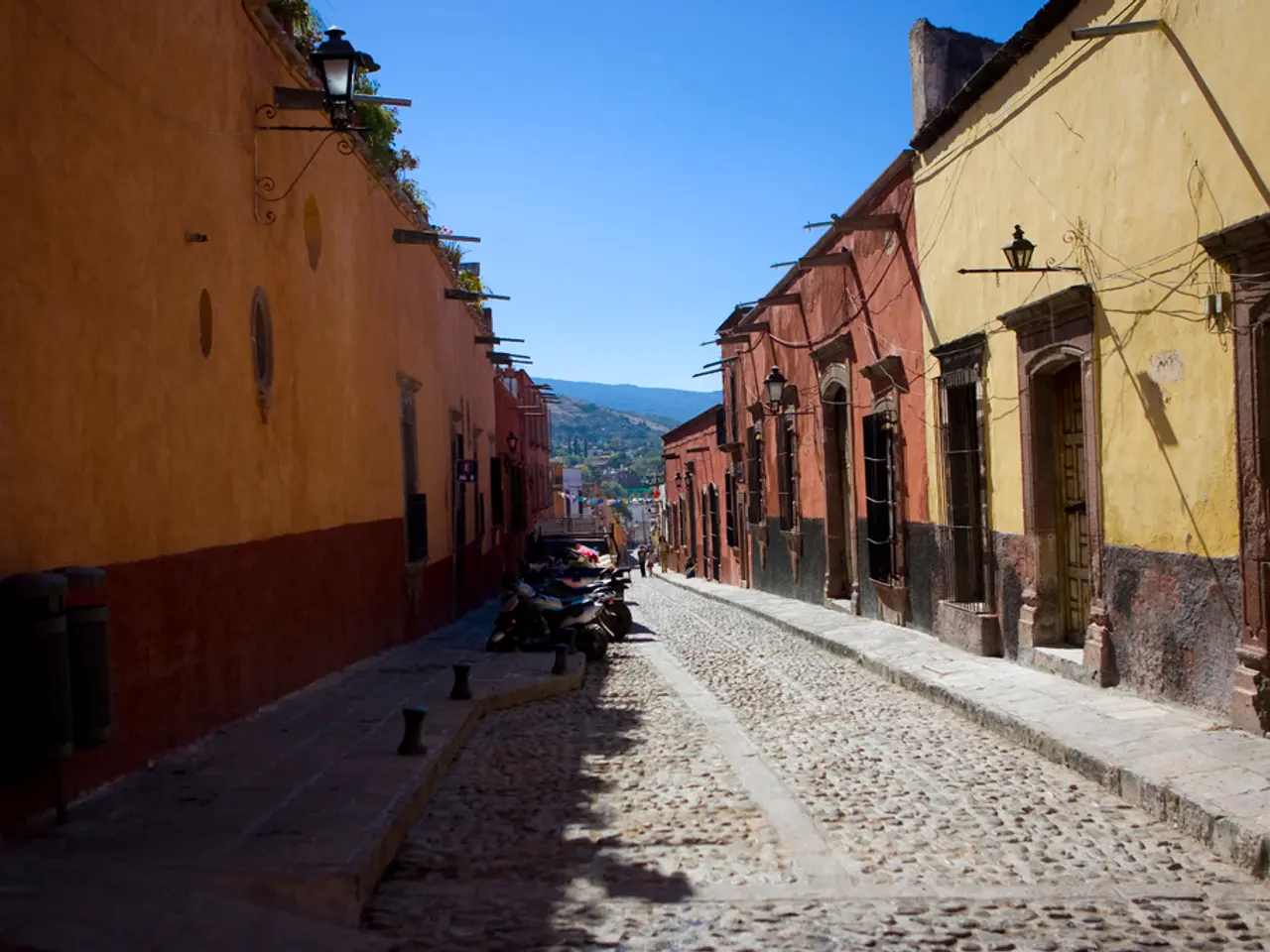persistent economic struggles in Argentina persist
Loose Cannon: Let's Talk Inflation, Baby!
Inflation, baby, it's the economic phenomenon that's taking the world by storm. Sure, some countries are chillin' with 1-3% inflation rates, but others? They're wrestling with rates that'd make your head spin, and Argentina is the queen bee of this wild ride.
You know inflation, right? It's when the purchasing power of money goes down across an economy. It happens when the government prints too much money and pushes it into circulation. Suddenly, folks have more cash to spend, and businesses are forced to raise the prices of their goods. It ain't just about cheap stuff, either. Loans? Mortgages?Big-time investments? All get affected.
When the price of everyday goods and services skyrockets, consequences follow like a dog chasin' its tail. People with fixed incomes get stuck, unable to keep up with the rising costs. An unpredictable housing market just makes things worse. Even those who can adjust are hesitant to make investments when things are all over the place.
In the good ol' USA, inflation talk's been a hot topic since the COVID-19 pandemic. For the past five years, it's been "inflation this" and "inflation that" – people freaking out 'cuz egg prices are goin' up, transportation's costing more, oil's gettin' more expensive – you name it, 'blame inflation.'
It's true, a dollar today is worth about sixteen cents less than it was four years ago, so prices are up by 1.16 times on average. It's also true that inflation's affected 93% of American households, and folks are stressin' about their financial futures. It's harder to buy groceries, pay the bills, send kids to school – it's all stressful for those livin' paycheck to paycheck.
But here's the kicker: the United States is experiencin' a minor case of inflation compared to the rest of the world. The U.S. inflation rate's currently 3%, putting it relatively low on the international inflation chart.
Most of the critical cases are in Africa and South America, in countries like Venezuela and Sudan. Most of these nations have struggled economically for decades.
While it ain't as bad as the hyperinflation of the Zimbabwean Dollar, Argentina's inflation rate's almost as high. The Argentina economy's been struggle city since 1975, with a peak of 249.793% inflation in 2024. That's 145.535% higher than Sudan, which has the next worst inflation rate.
The mess in Argentina's economy's a mix of decades-long struggle, and some major events played a crucial role. The first significant contribution was in the 1980s, when Argentina was hit by its first debt crisis. It started when the Banco de Intercambio Regional (BIR) failed. One of the largest private banks of the nation, its collapse instantly pushed the economy into chaos – millions lost their savings as the bank used them to pay off its debts to creditors and depositors. The Central Bank of Argentina tried to fix the problem by supporting other banks, but they faced the same fate.
Many other factors contributed to this event, with fiscal imbalances, increased global interest rates, and a sudden drop in commodity prices being the most notable. The Argentinian government, facing low tax revenue, kept borrowing money from the central bank to reduce its mounting debt. As a result, the banking system of Argentina became even more shaky and was unable to balance its budget. With conditions worsening every day, Argentine citizens started leavin' the nation, taking their money with them.
By the end of the decade, inflation had skyrocketed to 2600%. The government tried to take control of the situation when they implemented the Convertibility Plan of 1991 and the Central Bank Charter of 1992. The former reverted the exchange rate to one Argentine peso per one U.S. dollar and required the central bank to use international reserves to back Argentina's monetary base. The latter made the central bank independent from the government and affirmed its purpose to maintain the value of domestic currency. In addition to this, the government also removed many of its restrictions on foreign trade to open up the Argentine economy.
While the plan achieved some initial success, it ultimately failed when the country was plunged back into disarray in the early 2000s, mostly caused by a crisis in Brazil, Argentina's number one trading partner.
Carlos Zipilivan, President of Plus Mobile Communications and an Argentine citizen, explains, "When Brazil's in a bad way, dude, it's tough for Argentina." In the 1990s, Brazil was dealing with its own high inflation rate. Often, unstable currency leads to difficulties for emerging markets like Brazil. High inflation makes imports more expensive and exports less competitive. The problems tend to lead to accumulated debt, which only worsens the situation. When a country's in a crisis like this, its trading partners suffer, too – they're no longer getting as many goods, and they can't sell as many goods either. These nations compensate in various ways, but it rarely works out well.
Zipilivan also mentioned that, "During the second half of the nineties, the government was on a spending spree, man." They were spending more money than they had, and it wasn't consistent with keeping the one peso to one dollar exchange rate.
On November 30th of 2001, the Argentine peso experienced a significant devaluation, and interest rates soared across the country. Citizens started withdrawing their money from banks in a national bank run, worried that these institutions would collapse like they had a decade before.
On December 5, 2001, the International Monetary Fund (IMF) suspended financial aid to Argentina after the nation imposed a partial deposit freeze (prevents the transfer or withdrawal of certain funds in banks), which was a violation of the IMF's conditions for its support program for Argentina.
The country was left to fend for itself. With investor confidence plummeting, a renewed bank run intensified as people rushed to withdraw their deposits. In response, the government imposed the "Corralito" – a freeze on bank accounts – to prevent further capital flight.
Like before, the government took similar measures to address this issue, promoting domestic deflation and increasing fiscal accounts. But these attempts were fruitless, with limitations imposed by the convertibility law making it difficult to depreciate the value of the peso, and insufficient room for depreciation in prices and wages across the country. Moreover, many banks had short-term liabilities in dollars that they were unable to pay back due to financial dollarization – relying on U.S. currency – since they had no last-resort lenders of U.S. dollars.
As the weeks passed and conditions remained dire, the bank run continued. To stop the constant withdrawals of money, the government implemented a "fence" on money flow, preventing citizens from moving money out of their banks and allowing only for money to be transferred within them. Citizens were also prevented from collecting large amounts of cash at once. These measures were ineffective, as citizens couldn't access enough liquid money to buy daily necessities and other goods in the informal sector, causing economic activity to decrease significantly. The increased poverty and unemployment rates also caused a wave of social unrest in the nation.
Zipilivan confirms that the government was not taking proper measures to address the economic situation. "In 2003, Argentina had a populist government that took all the money from the reserves," he said. "They paid back international debts, limited access to U.S. dollars, and just kept printing pesos…they made local currency completely independent from foreign currency." Isolating a currency in this way can have multiple consequences: it makes it harder for the economy of a nation to integrate with those of other countries, making international trade and investment more difficult.
The Argentine economy suffered its worst crisis of its entire existence during this time, often being referred to as the Argentine Great Depression. In just a matter of weeks, the economy was turned upside down, and the daily lives of civilians changed drastically. Not only did the "fence" affect people's purchasing power and inhibit their ability to act as consumers, but it also incited so much frustration that people began protesting and rioting.
However, Argentina didn't stay in this state for long. Soon enough, the government determined that the only way to fix the issue would be through pesification, converting debts denominated in dollars to pesos at a rate of 1 U.S. dollar per 1 peso. This was hypothesized to work, since most individuals and businesses had their debts in the form of U.S. dollars (because of dollarization), and since the exchange rate between pesos and dollars was fluctuating greatly, converting the debts into pesos could reduce the cost of repayment.
The pesification strategy was ultimately effective and reduced bankruptcies nationwide, giving the Argentine economy the opportunity to grow.
The country stayed in a relatively stable condition for years until the global financial crisis in 2008. This conflict originated in the United States when a housing bubble consumed the nation. In the early 2000s, low interest rates and easy credit access led to a bustling housing economy. Home purchasing was also facilitated by mortgage lenders and bankers, who gave out loans to people with low credit scores. When banks made these risky investments, they bundled them together into mortgage-backed securities (MBS) and sold them to investors, banks, and pension funds. MBSs are attractive to investors because they offer a chance for high returns, even though they are associated with a high amount of risk.
Seeing that the demand for housing was at an all-time high, realtors started jacking up the prices for these homes in a way that couldn't be sustained by the general population. American citizens became unable to afford mortgages, leading the demand for housing to go back down. This resulted in an imbalance between the amount of available housing and people looking to purchase houses, causing homeowners and lenders to increase the mortgages and rents for then-current occupants.
Between 2007 and 2008, an alarming number of people defaulted on their loans. With that, the value of MBSs plummeted, and investors suffered massive losses. After Bear Stearns, Lehman Brothers, and other financial institutions involved with MBSs collapsed, global credit markets started freezing, and people were unable to get loans.
The economic recession was in motion. With the U.S. as its second-biggest trading partner, Argentina was instantly impacted. The Argentine peso began to devalue, causing imports to become increasingly more expensive. As an emerging market, American investors were hesitant to place their capital in Argentina, especially with its history of economic instability. This led to a decline in foreign direct investment.
The government responded to this crisis by implementing capital controls – such as withdrawal limits and limiting foreign ownership – across the nation and restricting access to foreign currencies. Additionally, the then-current President Cristina Fernández de Kirchner implemented stimulus spending to keep businesses running, raised taxes on exports to increase revenue and keep local businesses alive, and promoted social welfare programs to reduce poverty and prevent social unrest.
These efforts generated a mixed success. On the positive side, most businesses stayed alive, and employment remained stable. However, the Argentine economy isolated itself from the rest of the world, and its protectionist policies – restriction of imports and raised taxes on exports – made things more expensive for local consumers.
Since the 2000s, Argentina has not experienced any especially severe economic crises, but the nation remains unstable. Its inflation rate remains the highest among the nations, and a significant portion of the population still suffers from poverty. Iraq, unfortunately, continues to struggle with other issues.
However, Argentina has received more help than in the past. In 2018, the IMF provided its largest-ever loan of 50 billion dollars to help support the falling peso and encourage inward foreign investment. But this didn't turn out as intended. The government immediately put a significant portion of the money into the central bank to stabilize currency exchange rates by providing foreign currency reserves, and another large percentage of it was devoted to paying off Argentina's foreign debts. The loan did little to help the poor or address inflation. Instead, it imposed many austerity measures onto the country that stirred social unrest. Today, Argentina still has the significant financial burden of paying back the IMF.
As the government tries to pay off this debt, citizens are suffering. According to Zipilivan, "Today's policy is very hard because the government wants to pay the loan back, but they can't, so they stopped printing as much money," he explained. "Facilities like education and other local industries struggle because of that."
It's tough to know whether Argentina's economy will ever be stable. "I'm always concerned," Zipilivan admitted. "Maybe by miracle the government can come up with a solution, but it's not easy, and it's a shame because Argentina has so much potential."
In 2023, Argentina experienced a new round of rioting and social unrest after the government increased utility fees by 900%. The government claimed that the increase was necessary to reduce the nation's $400 billion dollar deficit. Protesters, however, argued that the government's austerity measures were hurting the poor.
After some of the most intense economic crises of the past few decades, recovery seems uncertain. The current president, Alberto Fernandez, has promised to implement economic reforms in an effort to stabilize the economy. However, he faces opposition from within his own government and from industry leaders who believe that his policies will only make things worse. It remains to be seen whether Argentina can turn things around and create a stable economic future for its citizens.
From housing bubbles to bank runs, Argentina's economic struggles are the stuff of nightmares. It's a rollercoaster ride that's made even wilder by unstable governments, global crises, and corruption. But through it all, one thing's clear: Argentina's got the potential to be a powerhouse, and it's a shame that it hasn't been able to reach that potential yet. So here's to Argentina, the wild child of economies – may she find her way and thrive.
- The wild ride of inflation can have significant impacts on personal-finance, affecting everyday expenses, loans, mortgages, and investments.
- As the world grapples with inflation, news headlines often talk about the role of finance, industry, and investing in shaping wealth-management strategies for both individuals and governments.
- Interestingly, the history of Argentina has been marked by intense economic struggles, including a tumultuous relationship with inflation that has been compared to that of other countries facing similar challenges, such as Sudan and Venezuela.
- As Argentina navigates its economic troubles, the global business community closely follows the nation's efforts to reform its financial system, hoping that Argentina can achieve a stable economy and unlock its full potential for growth and prosperity.








